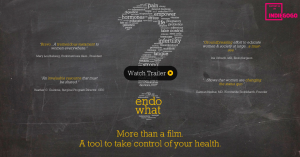 The facts are eye-opening, the experts are compelling, but it is the voices of women talking about their lived experience with endometriosis that have the biggest impact in Endo What?, the documentary about the disease that premiered in New York City on March 16, 2016, during #EndometriosisAwarenessMonth.
The facts are eye-opening, the experts are compelling, but it is the voices of women talking about their lived experience with endometriosis that have the biggest impact in Endo What?, the documentary about the disease that premiered in New York City on March 16, 2016, during #EndometriosisAwarenessMonth.
In one early scene, woman after woman states the number of years it took for their endometriosis to be diagnosed: 18 years, 20 plus years, more than 15, 22 plus, 13, 6, 13, 12, 10 years, years during which many were told their intense pain was normal, or it was in their heads, or they needed to see a psychiatrist, or they were drug-seeking, or worse.
One later describes her pain: “It just feels like someone is taking a roller and rolling up my insides, and it’s tighter and tighter, and then rubbing barbed wire through it.”
The pain caused by endometriosis is NOT normal.
The film’s director and co-producer Shannon Cohn experienced symptoms at 16 and was finally diagnosed at 29. She, too, was told her debilitating pain was normal. In a recent Newsweek article she said, “Millions of other women are basically told the same thing.”
If it takes on average 8 to 10 years from the onset of symptoms to be diagnosed with endometriosis, getting a diagnosis is no guarantee you will receive appropriate or effective medical care.The film makes clear how few real endometriosis experts there are, and how much unhelpful care and how many ineffective, even damaging, treatments are provided by medical professionals who don’t know the facts or still believe the myths about endometriosis.
Contrary to what you may have heard, very young women DO get endo (symptoms can start before the onset of menstruation), it is NOT a career women’s disease, pregnancy is NOT a cure, and hysterectomy—definitely—is NOT a cure.
Endometriosis is also a disease of associated conditions including irritable bowel syndrome, interstitial cystitis, pelvic floor muscular dysfunction, thyroid problems and chronic fatigue—all of which can complicate diagnosis and treatment.
As for treatment options, hormonal manipulation with birth control pills may manage symptoms for awhile but in no way treats the disease. Stronger drugs like Lupron and other GnRH agonists offer few benefits and many negative side effects, some of which may be permanent.
As Deborah Metzger, MD, PhD, puts it,
“The way we practice medicine is not conducive for what women with endometriosis need…It’s a chronic systemic issue and it needs solutions that are long-term….and using hormones and all those other things, those are Band-Aids.”
The best long-term treatment for endometriosis is surgery, but one of the most startling messages of the film is how few surgeons have the skill to perform laparoscopic excision surgery, considered the gold standard by experts. As one endo surgeon says, “It cannot be done by regular gynecologists as a routine surgery.” To be effective all lesions must be completely excised. Most surgeons use a laser to burn the surface of endometriosis, rather than cut it out, leading to continued pain and repeat surgeries. What endometriosis sufferers need, a voice in the film tells us, is “One surgery, done right.”
Endo What? also explores the connection between infertility and endometriosis—distortion of the reproductive tract by endometrial lesions and inflammation are key factors. Excision surgery can greatly improve the chance of conceiving.
The second half of the film focuses on what women can do post-surgery to restore their health and well-being. Physical therapy to relieve pelvic floor pain, nutritional counselling to restore digestive health and reduce inflammation, exercise, stress reduction strategies, and reducing exposure to environmental toxins and everyday chemicals can help aid recovery to health. A key message is that the disease is individual; what works for some may not work for others.
If the film’s goal is to make people care about endometriosis, it does this effectively by making the viewer care about the women who live with this disease. Be we friends, parents, family members or health-care providers of women with endometriosis, the onus is on all of us to learn the facts about a disease that affects one in 10, and an estimated 176 million worldwide. Medical students should not graduate until they’ve watched this documentary.
The film ends on a hopeful note. ‘There is life after endometriosis.” But to get there, women must be their own best advocates.
“Don’t accept what one or two or 10 doctors tell you is normal when you know that something is wrong,” one interview subject tells us. “Keep pushing until you find the right provider, they are out there.”
Let’s hope, as a result of this film, there will be more of them soon.
Endo What? will be available widely online on April 15th in the US and UK via digital download and DVDs. Watch the trailer here.
Laura Wershler is a veteran sexual and reproductive health advocate and writer, SMCR member, and editor-in-chief of re: Cycling.

